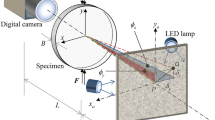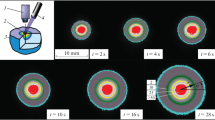Abstract
Thermal stress induced by elevated temperature causes the refractive index of transparent materials to become non-uniform, influencing the light deflection and thus performance of imaging systems containing such materials. Here, a digital gradient sensing (DGS) method is developed to measure the full-field non-uniform thermal stress in a material with air disturbance. This real-time optical technique can provide the light deflection and distribution of the principal stress gradients in a transparent medium. The light deflection through the transparent medium caused by the thermal stress is obtained using the elasto-optical effect. Air convection at elevated temperatures also affects the light deflection in optical systems, so the DGS method is extended to eliminate air convection. The light deflection resulting from the heated air is separately identified and calculated from the total deflection. The validity of this method is demonstrated using a bilayer transparent film containing layers with known refractive index and different thermal expansion coefficients that is bent by the thermal stress. Application of the DGS method to a zinc sulfide specimen shows that the thermal stress in it is temperature dependent and can be used to characterize refractive index non-uniformity.









Similar content being viewed by others
References
Schwarz J et al (2012) Measurement of nonlinear refractive index and ionization rates in air using a wavefront sensor. Opt Exp 20:8791–8803
Barney MC, Wayne GR, Paul M (2005) Dynamic in-situ temperature profile monitoring of a deep-UV post-exposure bake process. SPIE 4689:1133–1142
Mahdieh MH, Nikbakht M, Sobhani M (2011) Shock wave driven by high intensity nanosecond laser pulse in atmospheric air and2-D determination of refractive index variations of hot core air. Opt Commun 284:4828–4835
Reitmayer F, Schroeder H (1975) Effect of temperature gradients on the wave aberration in athermal optical glasses. Appl Opt 14(3):716–720
Haruna M et al (1998) Simultaneous measurement of the phase and group indices and the thickness of transparent plates by low-coherence interferometry. Opt Lett 23:966–968
Westphal V et al (2002) Correction of geometric and refractive image distortions in optical coherence tomography applying Fermat’s principle. Opt Exp 10:397–404
Tippur HV, Krishnaswamy S, Rosakis AJ (1991) A coherent gradient sensor for crack tip deformation measurements: analysis and experimental results. Int J Fract 48:193–204
Tippur HV (1992) Coherent gradient sensing: a Fourier optics analysis and applications to fracture. Appl Opt 31:4428–4439
Kirugulige MS, Tippur HV (2006) Mixed-Mode Dynamic Crack Growth in Functionally Graded Glass-Filled Epoxy. Exp Mech 46:269–281
Tippur HV (2010) Coherent gradient sensing method for fracture mechanics: a review, Fatigue Fract. Eng Mater Struct 33:832–858
Dong XL, Feng X, Hwang K-C, Ma SP, Ma Q (2011) Full-field measurement of nonuniform stresses of thin films at high temperature. Opt Exp 19:13201–13208
Dong XL, Zhang CX, Feng X, Hwang K-C (2013) Full-field measurement of topography and curvature by coherent gradient sensing method at high temperature. Exp Mech 53:959–963
Zhang CX, Dong XL, Feng X, Hwang K-C (2013) Multi-wavelength shearing interferometry for measuring the slopes, curvatures and shape of thin films/substrate system. Opt Lett 38:5446–5449
Peters WH, Ranson WF (1981) Digital Imaging Techniques in Experimental Stress Analysis. Opt Eng 21:427–431
Zhang D, Zhang X, Cheng G (1999) Compression strain measurement by digital speckle correction. Exp Mech 39(1):62–65
Huang D et al (1991) Optical coherence tomography. Science 254:1178–1181
Periasamy C, Tippur HV (2012) Full-field digital gradient sensing method for evaluating stress gradients in transparent solids. Appl Opt 51:2088–2097
Periasamy C, Tippur HV (2013) Measurement of orthogonal stress gradients due to impact load on a transparent sheet using digital gradient sensing method. Exp Mech 53:97–111
Periasamy C, Tippur HV (2013) Measurement of crack-tip and punch-tip transient deformations and stress intensity factors using Digital gradient sensing technique. Eng Fract Mech 98:185–199
Periasamy C, Tippur HV (2013) A full-field reflection-mode digital gradient sensing method for measuring orthogonal slopes and curvatures of thin structures. Meas Sci Technol 24:025202
Periasamy C, Tippur HV (2013) Nondestructive evaluation of transparent sheets using a full-field digital gradient sensor. NDT&E Int 54:103–106
Born M., Wolf E. (1999) Principles of optics: electromagnetic theory of propagation, interference and diffraction of light. Cambridge University Press, Cambridge
Zhang CX et al (2015) Full-field measurement of surface topographies and thin film stresses at elevated temperatures by digital gradient sensing method. Appl Opt 54(4):721–727
Timoshenko S (1925) Analysis of bi-metal thermostats. J Opt Soc Am 11:233–255
Beevers MS et al (1983) Studies of cyclic and linear poly(dimethyl siloxanes): 13. Static dielectric measurements and dipole moments. Polymer 24(1):1565–1570
Feng X et al (2006) The Effect of Thin Film/Substrate Radii on the Stoney Formula for Thin Film/Substrate Subjected to Nonuniform Axisymmetric Misfit Strain and Temperature. J Mech Mater Struct 1:1041–1053
Feng X, Huang Y, Rosakis AJ (2008) Multi-layer thin films/substrate system subjected to non-uniform misfit strains. Int J Solids Struct 45:3688–3698
Feng X, Huang Y, Rosakis AJ (2008) Stresses in a multilayer thin film/substrate system subjected to nonuniform temperature. J Appl Mech 75(2):021022
Acknowledgements
We gratefully acknowledge the support from the National Basic Research Program of China (Grant No. 2015CB351900), National Natural Science Foundation of China (Grant Nos. 11320101001, 11227801, and 11502127) and Tsinghua University Initiative Scientific Research Program.
Author information
Authors and Affiliations
Corresponding author
Rights and permissions
About this article
Cite this article
Zhang, C., Qu, Z., Fang, X. et al. Digital Gradient Sensing Method to Evaluate Thermal Stress at Elevated Temperatures. Exp Mech 56, 1123–1132 (2016). https://doi.org/10.1007/s11340-016-0160-3
Received:
Accepted:
Published:
Issue Date:
DOI: https://doi.org/10.1007/s11340-016-0160-3




